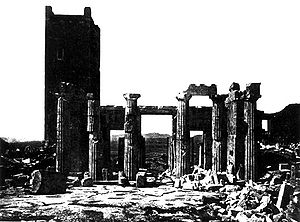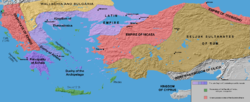- Duchy of Athens
-
Duchy of Athens
Δουκᾶτον ἈθηνῶνVassal state* ← 
1205–1458  →
→Arms of the Duchy under the de la Roche family
The Latin Empire with its vassals and the Greek successor states after the partition of the Byzantine Empire, c. 1204. The borders are very uncertain. Capital Athens Language(s) French
Catalan (from 1318)
Greek popularlyReligion Roman Catholic,
Greek Orthodox popularlyPolitical structure Vassal Historical era Middle Ages - Fourth Crusade 1204 - Duchy established 1205 1205 - Catalan Company rule 1318 - Acciaioli rule 1388 - Tributary to Morea 1444 - Ottoman conquest 1458 1458 *The duchy was a vassal of, in order, the Kingdom of Thessalonica, the Principality of Achaea, the Crown of Aragon, the Republic of Venice, and the Despotate of Morea The Duchy of Athens was one of the Crusader States set up in Greece after the conquest of the Byzantine Empire during the Fourth Crusade, encompassing the regions of Attica and Boeotia, and surviving until its conquest by the Ottoman Empire in the 15th century.
Contents
History
Establishment of the Duchy
The first duke of Athens (as well as of Thebes, at first) was Otto de la Roche, a minor Burgundian knight of the Fourth Crusade. Although he was known as the "Duke of Athens" from the foundation of the duchy in 1205, the title did not become official until 1260. Instead, Otto proclaimed himself "Lord of Athens" (in Latin Dominus Athenarum, in French Sire d'Athenes). The local Greeks called the dukes "Megas Kyris" (Greek: Μέγας Κύρης, "Great Lord"), from which the shortened form "Megaskyr", often used even by the Franks to refer to the Duke of Athens, is derived.
Athens was originally a vassal state of the Kingdom of Thessalonica, but after Thessalonica was captured in 1224 by Theodore, the Despot of Epirus, the duchy became a vassal of the Principality of Achaea. The Duchy occupied the Attic peninsula and extended partially into Thessaly, sharing an undefined border with Thessalonica and then Epirus. It did not hold the islands of the Aegean Sea, which were Venetian territories, but exercised influence over the Latin Lordship of Negroponte. The buildings of the Acropolis in Athens served as the palace for the dukes.
Aragonese Conquest
The Duchy was held by the family of la Roche until 1308, when it passed to Walter V of Brienne. Walter hired the Catalan Company, a group of mercenaries founded by Roger de Flor, to fight against the Byzantine successor states of Epirus and Nicaea, but when he tried to cheat and kill them in 1311, they slew him at the Battle of Halmyros and took over the Duchy, making Catalan the official language and replacing the French and Byzantine-derived laws of the Principality of Achaea with the laws of Catalonia. Walter's son Walter VI of Brienne retained only the lordship of Argos and Nauplia, where his claims to the Duchy were still recognized.
In 1318/1319 the Catalan Company conquered Siderokastron and the south of Thessaly and created the Duchy of Neopatras, united to Athens. Part of Thessaly was conquered by the Serbs in 1337.
Under the Catalans, the feudal system continued to exist, not anymore under the Assizes, but under the Customs of Barcelona, and the official common language was now Catalan instead of French. Each city and district—on the example of Sicily—had its own local governor (veguer, castlà, capità), whose term of office was fixed at 3 years and who was nominated by the Duke, the vicar or the local representatives. The principal towns and villages were represented by the síndic, which had their own councils and officers. Judges and notaries were elected for life or even as inherited offices.
Decline and fall
 A Frankish tower, dating to either the Burgundian or Catalan period, stood on the Acropolis of Athens among the ruins of the Parthenon, then a church dedicated to Saint Mary, until it was dismantled in 1874.
A Frankish tower, dating to either the Burgundian or Catalan period, stood on the Acropolis of Athens among the ruins of the Parthenon, then a church dedicated to Saint Mary, until it was dismantled in 1874.
In 1379 the Navarrese Company, in the service of the Latin emperor James of Baux, conquered Thebes and part of Neopatria. Meanwhile, the Aragonese kept another part of Neopatras and Attica.
After 1381 the Duchy was ruled by the kings of Aragon until 1388 when the Acciaioli family of Florence bought Athens. Neopatras was occupied in 1390.
From 1395 to 1402 the Venetians briefly controlled the Duchy. In 1444 Athens became a tributary of Constantine Palaeologus, the despot of Morea and heir to the Byzantine throne. In 1456, after the Fall of Constantinople (1453) to the Ottoman Empire, Turahanoğlu Ömer Bey conquered the remnants of the Duchy. Despite the Ottoman conquest, the title of "Duke of Athens and Neopatras" continued in use by the kings of Aragon, and through them by the Kings of Spain, up to the present day.
The Latin church in the duchy of Athens
Athens was the seat of an archdiocese within the Patriarchate of Constantinople when it was conquered by the Franks. The bishopric, however, was not of importance, being the twenty-eighth in precedence in the Byzantine Empire.[1] Nonetheless, it had produced the prominent clergyman Michael Choniates. It was a metropolitan see (province or eparchy) with eleven suffragans at the time of conquest: Euripus, Daulia, Coronea, Andros, Oreos, Scyrus, Karystos, Porthmus, Aulon, Syra and Seriphus, and Ceos and Thermiae (or Cythnus). The structure of the Greek church was not significantly changed by the Latins, and Pope Innocent III confirmed the first Latin archbishop of Athens, Berard, in all his Greek predecessors' rights and jurisdictions. The customs of the church of Paris were imported to Athens, but few western European clergymen wished to be removed to such a distant see as Athens. Antonio Ballester, however, an educated Catalan, had a successful career in Greece as archbishop.
The Parthenon, which had been the Orthodox church of the Theotokos Atheniotissa, became the Catholic Church of Saint Mary of Athens. The Greek Orthodox church survived as an underground institution without official sanction by the governing (Latin) authorities. The Greek clergy had not typically been literate in the twelfth century and their education certainly worsened under Latin domination, when their church was illegal.[2]
The archdiocese of Thebes also lay within the Athenian duchy. Unlike Athens, it had no suffragans.[3] However, it produced several significant figures as archbishops, such as Simon Atumano. It had a greater political role than Athens because it was situated in the later capital of the duchy at Thebes. Under the Catalans, the Athenian diocese had expanded its jurisdiction to thirteen suffragans, but only the diocese of Megara, Daulia, Salona, and Boudonitza lay with the duchy itself. The archiepiscopal offices of Athens and Thebes were held by Frenchmen and Italians until the late fourteenth century, when Catalan or Aragonese people began to fill them.
Dukes of Athens
De la Roche family
Of Burgundian origin, the dukes of the petty lordly family from La Roche renewed the ancient city of Plato and Aristotle as a courtly European capital of chivalry. The state they built around it was, throughout their tenure, the strongest and most peaceful of the Latin creations in Greece. After the De la Roche family gave the duchy of Athens to the Briennes, some of them moved back to their castle (located 40 kilometers from Paris) while others stayed at the east part of Attica. The De la Roche name changed. It became Rosis, Rosas, Rokas and finally Papavasileiou, due to a small civil war. The Papavasileiou family still owns a big part of what used to be the De la Roche estate in Attica.[citation needed]
Briennist claimants
The Athenian parliament elected the count of Brienne to succeed Guy, but his tenure was brief and he was deposed in battle by the Catalans. His wife briefly had control of the city, too. The heirs of Brienne continued to claim the duchy, but were recognised only in Argos and Nauplia.
- Walter V of Brienne (1308–1311)
- Joanna of Châtillon (1311–1354)
- Walter VI of Brienne (1311–1356)
- Isabella of Brienne (1356–1360)
- Sohier of Enghien (1356–1367)
- Walter IV of Enghien (1367–1381)
- Louis of Enghien (1381–1394)
Catalan domination
The annexation of the duchy to first the Catalan Company and subsequently the Mediterranean Aragonese Empire came after a disputed succession following the death of the last Burgundian duke. The Catalans recognised the King of Sicily as sovereign over Athens and this left the duchy often as an appanage in the hands of younger sons and under vicars general.
- Roger Deslaur (1311–1312)
- Manfred (1312–1317)
- Berenguer Estanyol (1312–1317)
- William II (1317–1338)
- Alfonso Frederick (1317–1338)
- John II (1338–1348)
- Frederick I (1348–1355)
- Frederick II (1355–1377)
- Maria (1377–1388)
- with Peter IV of Aragon from 1381
Vicars
These were the vicars general of Aragon who served between 1381 and 1388.
- Mateu de Montcada
- Roger de Llúria
- Mateu de Peralta
- Louis Fadrique
- Dalmau IV of Rocabertí
- Bernat de Cordella
Acciaioli family
The Florentine Acciaioli (or Acciajuoli) governed the duchy from their removal of the Catalans, with the assistance of the Navarrese. While Nerio willed the city and duchy to Venice, it returned to the Florentines until the Turkish conquest.
- Nerio I (1388–1394)
- Antonio I (1394–1395)
- Venetian control (1395–1402), under podestàs:
- Albano Contarini (1395–1397)
- Lorenzo Venier (1397–1399)
- Ermoaldo Contarini (1399–1400)
- Nicolo Vitturi (1400–1402)
- Antonio I (1402–1435), again
- Nerio II (1435–1439)
- Antonio II (1439–1441)
- Nerio II (1441–1451), again
- Claire (1451–1454)
- with Bartolomeo Contarini (1451–1454)
- Francesco I (1451–1454)
- Francesco II (1455–1458)
Notes
Sources
- Setton, Kenneth M. Catalan Domination of Athens 1311–1380. Revised edition. London: Variorum, 1975.
Crusader States Levant Latin Greece Latin Empire · Kingdom of Thessalonica · Principality of Achaea · Duchy of Athens · Duchy of Neopatria · Duchy of the Archipelago · Lordship of Negroponte · County palatine of Cephalonia and Zakynthos · Lordship of Chios · Kingdom of Candia · Republic of Venice (Stato da Màr) · Knights HospitallerBaltic Categories:- Former countries in the Balkans
- Former vassal states
- States and territories established in 1205
- States and territories disestablished in 1458
- 1456 disestablishments
- Duchy of Athens
- Principality of Achaea
- Crusader states
- Byzantine Empire successor states in the Balkans
Wikimedia Foundation. 2010.


